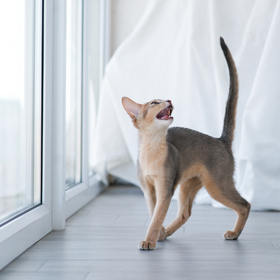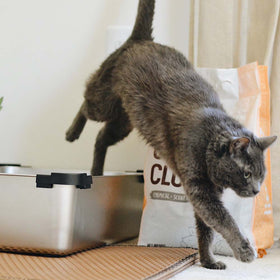
The Safe Outdoor Cat
The question of whether you should let your cat roam freely is one that doesn’t have an easy answer. Most cats, given the proper enrichment and stimulation, are happy indoors. However, there are some cats that require more, and should your cat be one that has unequivocal opinions on this score, there are some basic precautions you can take before you let your best friend roam freely.
Microchip
Microchipping is something that should be done with every cat, even if you never intend to let them outside. Even the best-intentioned cat guardian can momentarily lose control.
Unexpected escapes can happen with a faulty carrier latch, a weak window screen, a guest or worker neglecting to close a door, or simply a startled, frightened, playful, or bored cat who sees an opportunity. A microchip is your best chance of getting your lost cat back home again.
When getting your cat microchipped, always check that your information has been added to the record and that it’s correct. Don’t assume your vet clinic has done this for you, even if they say they will! Double check for yourself, and make sure if your information changes (e.g., moving house or a new phone number) that you update it.
Vaccinate
Many cat owners don’t get their cats vaccinated, which is understandable when the chances of their indoor cat coming into contact with another animal are low. But if your cat goes outside, there are many fatal and preventable diseases that can be spread to your cat from other animals, such as FIP, FIV, feline leukaemia, and rabies.
Let your vet knows that your cat goes outside and they’ll be able to recommend the best vaccine course to keep them as safe and healthy as possible.
Neuter and Spay
Millions of unwanted cats are euthanized every year. There’s no shortage of cats in the world—only a shortage of people willing to look after them. If your cat has kittens, it’s your responsibility to make sure every kitten finds a loving home with a responsible human. This doesn’t mean posting an ad on social media for free kittens: finding homes for an animal means doing background checks, doing house checks, and looking at references.
Apart from the kitten question, however, there are also increased health risks that are inherent to unsterilized pets. Most notably, sterilizing your cat decreases their urge to roam, keeping them closer to home.
Intact males are more aggressive and territorial, leading to more fights with competing animals, which in turn increases risk of injury and disease. They’re also at risk of developing testicular cancer.
For females, repeated pregnancies are incredibly hard on their bodies, especially when they occur multiple times a year. Intact females are also at risk of developing pyometra (a potentially fatal infection of the uterus) and uterine cancer, and are at an increased risk of developing mammary cancer.
Check for Fleas and Ticks and Regularly Deworm
For a free-roaming cat in the warmer months of the year, it’s almost inevitable that they’ll be bringing some unpleasant pests home.
There are a lot of adverse side effects associated with flea and tick treatments, and if you need to use them and opt for a product from your vet, it’s better to use the topical spot-on solutions rather than the oral options. Side effects from oral treatments can be more severe. While the spot-on solutions are not without their side effects, they’re at least less risky to your pet while still being an effective option.
If your cat already suffers from neurological symptoms, including anxiety, it’s better to avoid chemical flea and tick treatments altogether. Opting for more natural treatments may be safer, though it’s important you make sure a product is suitable for cats before you use it, since many dog products can be incredibly toxic for cats. It’s also important to remember that there is no regulation surrounding over-the-counter flea and tick treatment for pets, so make sure you trust the company you’re buying from.
It should be noted that no treatment is infallible, and especially in the warmer months when ticks are most active, checks should be done every day. When checking for ticks, make sure you pay attention to all those hard to reach places, like the back of the neck, under the arms, and the groin. An engorged tick can look a lot like a fleshy lump.
You can remove a tick yourself, but it’s important you do it properly or you can make the situation worse. Most vets don’t charge for tick removal, so if you’re squeamish or uncertain about doing it yourself, have it done at your vet’s office. But it’s important that the tick’s removed as soon as possible, so if it’s a Friday evening, don’t wait till your vet is open on Monday again to have it done.
Train Your Cat To Come When Called
Training your cat is a great way to stimulate and entertain them as well as to increase the bond between you. But it also has added practical benefit if you’re able to train your cat to come when called. When training, use the thing they love the most as a reward; this can be a treat, some extra attention, or a favourite toy. Make sure you train them inside before you let your cat out.
Use a Collar
Using a collar ensures that when your cat is outside, people will know they belong to someone. It’s also handy to put identification tags and bells on.
If you’re concerned about your cat getting stuck on something while crawling through a bush or under a fence, breakaway collars are a great solution. However, be prepared for the fact that you may have to replace it occasionally.
Get a Tag for That Collar
Get a tag that will fit your address, phone number, and your cat’s name on it. Not only is this helpful should your cat get lost, but it also means a quick identification in case of accident or injury.
You can get engraved tags, or you can get cheaper plastic ones that you write on yourself, which is a less expensive option if your cat is in the habit of losing their collar often.
If you take your cat to the cottage with you, make sure to have a second tag with your cottage’s address.
Put a Bell (or Bib) on It
Not only do bells help warn prey animals of your cat’s presence, they also let you hear when your cat is nearby, which, while not super practical, is great for your peace of mind when they’re hanging around but just not in the mood to come back inside.
Multiple studies have shown that a bell on a cat’s collar reduces the amount of prey killed by about half and that the sound has no effect on your cat’s comfort. A small study done in the UK also suggested that feeding a raw diet could help kerb a cat’s hunting tendencies.
If you’re still not comfortable with the idea of a bell, using a brightly coloured cat bib designed specifically for the hunting feline works just about as well as a bell, though it’s more effective on birds than on small mammals.
Add a Tracker
There are a few different trackers on the market these days with different pros and cons. Make sure you do your research and read reviews before you buy. Keep in mind size, weight, and signal limitations when looking at products.
Establish a Schedule
Cats thrive on routine, and you can harness this aspect of their personalities to help them keep safe.
Keeping them on a schedule means they’ll know when to come back, and it’ll also minimize the chances they’ll start harassing you at inopportune times. For example, you might let them out after breakfast and let them back in before a set dinner time.
Keep Them Inside After Dark
Many of the animals that a cat naturally preys on are most active at night, but this is true for the other side as well: many of a cat’s natural predators, such as coyotes and foxes, are most active at night.
Cats and raccoons also tend to share territory, which isn’t a big deal when one of those animals sleeps through the time when the other is out roaming, but at night, if both animals are active in the same territory, the likelihood of a fight breaking out will increase and so will your cat’s chances of being injured or even killed.
Go Out with a Full Belly, Come Home with an Empty One
Not only does feeding them before they go out help keep them from moving in with that neighbour who always has the junky kibble on hand, it also keeps them from trying to supplement their diet with the local wildlife population.
It’s also important to feed them something they actually enjoy eating. Knowing they have a delicious meal waiting for them to come home to encourages them to return on time.
Keep Them Warm and Hydrated
Make sure you leave them well-prepared to deal with the elements, especially if you let them out during a time when you won’t be at home to let them back in again.
During the winter, have a lined and sheltered box where they can keep themselves warm with a temperature controlled bowl for water.
During the summer, have plenty of water and somewhere safe nearby in the shade where they can find relief until you return.
However, you should avoid leaving food out for them to snack on during their adventures. Not only does this attract potential predators and other cats, but a hungry cat is a cat that comes home again.
Keep Up-to-Date Clear, Coloured Photographs
Keep clear photos of their faces, bodies, and any distinct markings. If the worst happens and your cat goes missing, posters should be plentiful, in full colour, include as much information as possible, and have the offer of a monetary reward.
Leave your information with all vet clinics in the area and ensure that your contact information on their microchip is up to date.
Get in contact with all local shelters and rescue organizations that someone might reasonably contact in the event they find your cat.
Post to neighbourhood groups on social media, and make a posts on online lost pet databases.
Ask neighbours if you can check their sheds, basements, garages, and under their porches. A frightened cat may remain in hiding if a stranger calls them, but if they recognize your voice, they’re much more likely to come out of hiding.
Your cat is most likely to return late at night or very early in the morning when everything is quiet. If it’s possible and safe, keep your door open. (You can camp out in the nearby living room or hallway.) If they do return, make sure you stay calm and do not approach or call out to them until they’re safely back inside. You can also set out cameras to keep an eye on the area overnight to see if they’re coming back.
Avoid leaving their litter box or food outside because these can attract predators and other hungry animals that might scare your cat off.
Set up a cat trap with something that smells familiar and safe, such as a favourite blanket or toy and an item of used laundry that smells like you. Cover the trap with a large blanket or towel that has a familiar scent, then set it up in the place they would most likely come to be let back inside.
Remember that Safer Alternatives Exist
In the end, whatever measures you take, letting your cat roam is always going to carry some increased risk, both to them and to the local wildlife populations.
If your cat is bored and restless inside, there are ways to make your space more cat friendly. Search for ideas on catification and training to infuse some more interest in your indoor cat’s life.
Additions to your outdoor space in the form of catios is also a great option. These can be large, elaborate structures set up in a backyard or even just a small enclosure built out from a window. Just make sure anything you create is secure and solid—having a professional construct it is always the best way.
Harness and leash walking can work for some cats, though it takes some preparation and training. Taking your cat for walks in enclosed strollers can also be a fun way to expose them to new sights and smells without exposing them to any risk.
In the end, your cat is depending on you to make the best choices for their health and happiness. Doing plenty of research, talking to professionals, knowing your cat, and understanding how your decisions affect them is the best way to do this.









